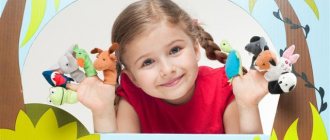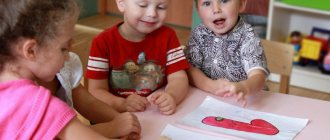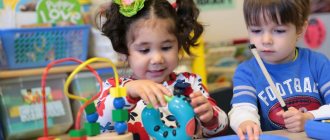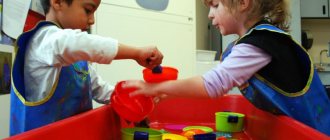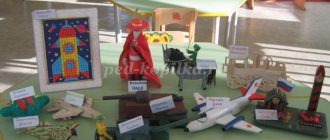Independent play activities of preschool children
Zhiltsova Inna Anatolyevna
Independent play activities of preschool children
In the pedagogical theory of play, special attention is paid to the study of play as a means of education. The fundamental position is that in preschool age play is the type of activity in which the personality is formed and its internal content is enriched. The main meaning of the game associated with the activity of imagination is that the child develops the need to transform the surrounding reality, the ability to create something new.
The educational possibilities of all types of games are extremely great. It is important for adults to implement them in such a way as not to disrupt the natural flow of the game and not to deprive it of its “soul”
a remark, an indication, a notation, just a careless word.
The relevance of this topic is due to the introduction into practice of the Federal State Standard of Preschool Education (hereinafter referred to as the Federal State Educational Standard for Preschool Education), the Federal Law “On Education in the Russian Federation”
and the need to reconsider the organization
of play activities in preschool educational institutions in accordance with the requirements for preserving the uniqueness and intrinsic value of preschool childhood as an important stage in the overall development of a person.
The novelty lies in the formation in teachers of the ability to organize play activities a way that will ensure “diversity of childhood, full-fledged living by the child at all stages of preschool childhood , amplification (enrichment)
child development, creating a favorable social situation for the development of each child in accordance with his
age and individual characteristics and inclinations.”
of a preschool child are expressed in play . First of all, a child is characterized by a desire for independence and active participation in the lives of adults. As the child develops, the world he is aware of expands, and an internal need arises to participate in adult activities that are inaccessible to him in real life. In play, the child takes on a role, trying to imitate those adults whose images have been preserved in his experience. While playing, the child acts independently , freely expressing his desires, ideas, and feelings.
As a leading activity , play most contributes to the formation of a child’s new formations, his mental processes, including imagination. One of the first to connect the development of play with the characteristics of children's imagination was K. D. Ushinsky. He drew attention to the educational value of images of imagination: the child sincerely believes in them, therefore, while playing, he experiences strong, genuine feelings.
The basis of the new classification of children's games, developed by S. L. Novoselova, is the idea of on whose initiative games arise (child or adult)
.
There are three classes of games:
1. games that arise on the initiative of the child ( children , - independent games :
1.1. game-experimentation;
1.2. independent plot games : plot-display, plot-role-playing, director's, theatrical;
2. games that arise on the initiative of an adult who introduces them for educational and educational purposes:
2.1. educational games: didactic, plot-didactic, active;
2.2.leisure games: fun games, entertainment games, intellectual games, festive carnival games, theatrical performance games;
3. games that come from the historically established traditions of the ethnic group (folk, which can arise on the initiative of both an adult and older children : traditional or folk (historically they form the basis of many educational and leisure games).
Directing games are a type of creative games. In them, as in all creative games, there is an imaginary or imaginary situation. The child shows creativity and imagination, inventing the content of the game, determining its participants (roles that “perform”
toys, objects). Objects and toys are used not only in their immediate meaning, but also figuratively, when they perform a function that is not assigned to them by universal human experience. Children willingly resort to substitute toys in role-playing games, which indicates the development of imagination.
In director's games, the child himself creates the plot of the game, its script.
The basis of the role-playing game is an imaginary or imaginary situation, which consists in the fact that the child takes on the role of an adult and performs it in a play environment .
Children's independence in role-playing games is one of its characteristic features. Children themselves choose the theme of the game, determine the lines of its development, decide how they will reveal the roles, where the game will unfold.
Theatrical games are the acting out of literary works (fairy tales, short stories, specially written dramatizations)
.
The heroes of literary works become characters, and their adventures, life events, changed by children's imagination, become the plot of the game. It is easy to see the peculiarity of theatrical games: they have a ready-made plot, which means the activity is largely predetermined by the text of the work.
Creative role-playing in a theatrical play is significantly different from creativity in a role-playing game. In the last game, the child is free to convey the characteristics of role behavior.
However, one should not think that in any game a child’s acquisitions have a positive meaning. N.K. Krupskaya emphasized the polar influence of play on a child’s development, depending on the content of the activity . Numerous psychological and pedagogical studies have convincingly proven that the diversified development of a child occurs through play.
On the one hand, play is an independent activity of a child ; on the other hand, the influence of adults is necessary for the game to become his first “school”
, a means of education and training.
Making a game a means of education means influencing its content and teaching children ways to fully communicate.
“Organization of independent activities of preschool children in the context of the implementation of the Federal State Educational Standard”
#Educational and methodological materials #Presentation #Educator #Preschool education
“Pedagogical bag” (From work experience) “Organization of independent activities of preschoolers in the context of the implementation of the Federal State Educational Standard” Completed by: teacher of Municipal Educational Institution Kindergarten No. 359 O.A. Almyasheva
In the Federal State Educational Standard for Education, the independent activities of children are highlighted less clearly than the joint activities of adults and children. However, in the target guidelines, independence, the ability to choose one’s occupation, is paramount. The need for the formation and development of independence is dictated by the needs of society for non-standard people who can think creatively and make discoveries for the benefit of humanity. And the solution to this issue is reflected in the process of developing independence, which allows a person to pose new problems and find new solutions.
What conditions need to be created in a preschool educational institution for independent children’s activities? The construction of a subject-spatial environment by adults should make it possible to organize both joint and independent activities of children. In this case, the environment performs educational, developmental, nurturing, stimulating, organizational, and communicative functions. But most importantly, it works to develop the child’s independence and initiative.
Game Activity Center Design Center Patriotic Education Center
Fine Arts Center Book Center
Nature Center
Theater Center Musical class=”aligncenter” width=”800″ height=”600″[/img]
Traffic rules center
Our group has created a diverse gaming environment (subject-spatial environment), which provides the child with cognitive activity, corresponds to his interests and is developmental in nature. The created environment provides children with the opportunity to act individually or together with peers, without imposing mandatory joint activities. Every child has the opportunity to do what they love. Such an environment meets the individual and age characteristics of children and their leading activity – play.
Classification of games Children's games are very diverse. They differ in content and organization, rules, impact on the child, types of objects used, origin, etc. * Games that arise on the child’s initiative: - game-experimentation; - independent story game; Games that arise on the initiative of an adult: - educational: didactic, active, - leisure: game-fun, game-entertainment, theatrical, intellectual, festive-carnival; Games coming from the historically established traditions of the ethnic group: traditional or folk Creative games: plot-role-playing, construction-constructive, directing, dramatization games
Circles of Llull
Desktop layout "City"
Role-playing game "Driver's license" Passing exams at driving school Theory Practice
We undergo a medical examination
And here it is...a happy moment! Presentation of the certificate.
Role-playing game "Supermarket" Role-playing game "Atelier" Role-playing game "Hospital" Role-playing game "Barbershop"
Author’s, together with children “My City”
"Magic Tree"
“Checkers are friends with traffic rules”
“Cut pictures” “Memory” (pairs) “Assemble a sign” “CUBE”
“Sun and Snowman” (Art) “Decorate the Board” (Art) “Ladybugs” (Mathematics) Patriotic education
Play in a group is organized, firstly, as a joint game between the teacher and the children, where the adult acts as a playing partner and at the same time as a carrier of a specific “language” of the game. The natural emotional behavior of the teacher, who accepts any children’s plans, guarantees freedom and ease, the child’s enjoyment of the game, and contributes to the desire in children to master the methods of play themselves. Secondly, at all age stages, play is preserved as a free independent activity of children, where they use all the play tools available to them, freely unite and interact with each other, where the world of childhood is ensured to a certain extent, independent of adults.
Along with play, free productive activity of children (constructive, visual, etc.) occupies a significant place in a child’s life. Just like in play, the child’s development opportunities are enriched here. A circle “One palm, two palms” was organized
The next optimal condition for organizing independent children's activities is the special organization of educational activities. To do this, it is necessary to look for and apply more effective means of education and training that serve the development of children’s cognitive abilities. One of the promising methods is the design method.
Thus, the development of children's independence is one of the most important educational guidelines necessary for the successful socialization of the child and the development of his personality as a whole, and for creating a developmental and emotionally comfortable educational environment for him, in particular.
The teacher’s skill is most often manifested in organizing children’s independent activities. How to direct each child to a useful and interesting game without suppressing his activity and initiative? How to alternate games and distribute children in a group room or area so that they can play comfortably without disturbing each other? How to eliminate misunderstandings and conflicts that arise between them? The comprehensive upbringing of children and the creative development of each child depend on the ability to quickly resolve these issues.
Why does your preschooler need free play?
- Nikolaeva Irina
- March 7, 2021
- Preparation for school
Children interact with the world around them through play. Free play in early childhood is about exploration, experimentation, discovery and learning.
What is free play?
There are two types of play activities - adult-led play and child-led play. Both are important for a child's development.
You can't just let your child play 24 hours a day and grow on his own, but you also shouldn't fill his days with activities that take up his free time.
And time spent behind the tablet screen should not replace free play. This will only lead to developmental problems and difficulties in learning at school.
Here are some examples of adult-led play activities:
- drawing with your child
- setting up an obstacle course in the garden
- take your child to a pottery class or art class
- play the game i spy
Free play is any play that is initiated by the child. Outdoor play and indoor play can be considered free play as long as your child has free control over their play experience.
If you are a teacher or parent who understands the importance of a child's general intellectual development and appreciates the importance of a play-based approach for preschoolers, you will enjoy a comprehensive school preparation program.
Free Play Examples
- Outdoor games - tricycle riding, climbing, running, chasing, swinging, etc.
- changing clothes
- block game and construction
- puzzles
- play games indoors (such as board games)
- competitive outdoor games
- playing in sand and water
- creative art
Why is free play so important?
During preschool, much of a child's development occurs during free play. A smaller portion will come from adult-led activities.
Preschoolers are in the developmental stage of informal learning through play. Forcing academic and formal learning will not prepare your child for school.
Free play is responsible for:
- Personal, social and emotional development of the child
- Cognitive development and problem solving ability
- Physical development
- Development of language and communication skills
- Healthy Brain Development
Here's a quick look at 12 areas where free play will evolve.
Brain Development
Free play is important for a child's overall brain development. As children explore and learn, they form new connections and pathways in the brain.
A child's brain processes data twice as fast as an adult's. This is a significant amount of brain development. The stimulation a child receives early in life determines how many neurons are formed and which are not.
Creation
Play is a creative activity. Children are constantly coming up with new games and activities to entertain themselves.
For example, during fantasy play, children create stories and events and act them out as if they were happening. In artistic activities, children develop visual creativity. When you play with construction toys, building design gets creative.
Social skills
The first way a child can learn social skills is by interacting with their parents. After this, social interaction is built by playing with siblings or friends.
During free play, children learn many social skills, such as:
- cooperation with others
- play with others for a common goal
- negotiation
- learn to follow the rules
- think about others and see their points of view
- fair and independent conflict resolution
- Affirming myself
- following someone else's example
- sympathy and empathy
- socially acceptable behavior
- effective communication
Planning skills
Planning skills are important in early grades. They help the child learn to plan before starting work or to complete a task logically and within a given time frame.
During the game, planning skills are constantly improved. Whether a child plans a house before building it or plans where to stick a picture on a page, with time and practice he will develop the ability to plan.
Planning is a skill that requires careful thought and consideration. The child learns to think about the desired outcome before starting and takes time to think about how to complete the task.
A child with poor planning skills might start to draw a picture of his family but run out of space on the page for some of his family members, while a child with good planning skills will first look at the available space and decide how much space each person will take up on the page.
Playing a game is a great way to practice physical planning before moving on to planning on paper.
Motor development
A child's gross motor and fine motor skills develop largely through free play. Children need well-developed motor skills to learn to read and write.
Children develop motor skills from the center of the body to the extremities. In other words, their big muscles develop first, and then their small ones.
Large muscles are developed through free play such as:
- walking and running
- mountaineering
- jump, jump and bounce
- crawl
- push and pull
- catching and throwing
Small muscles are developed through free play such as:
- play with the pegboard
- modeling plasticine
- building with blocks or construction toys
- drawing and painting
- cutting and pasting
- threading and lacing
In recent times, increased tablet use and decreased gaming time have had a huge impact on children. More and more children have underdeveloped motor skills and, as a result, have difficulty learning.
Problem solving
Every child will face many challenges during their gaming sessions. They'll have to figure out how to stop their tower from toppling over, how to make a tent out of blankets, or how to change the rules of the game to make everyone happy.
Knowing how to solve problems is a skill that is needed in school and in adulthood, and even a critical skill needed in every person's career.
The beauty of problem solving during play is that when children are relaxed and engaged in what they choose, they don't see problems as problems. Rather, they are simply problems that need to be solved.
The more a child is interested in solving a problem, the more determined he will be.
This is a healthy approach to adulthood where problems can never be avoided and are best seen as challenges.
Speech development
Children usually verbalize what they are doing during play, even when they are alone. Not only do they increase their vocabulary , but they also practice language structures and sentence construction.
Playing with others provides even more opportunities for language learning as they interact and learn from each other.
Independence
When children are used to having free time to play every day, they develop a sense of independence and enjoy socializing with themselves and their peers.
As a parent, it is important not to be present at every play session, otherwise your child will develop a dependence on you to always be there.
This is also true for play, which is a healthy and important part of a child's youth. Try not to plan any aspects of the date and allow your child to exercise her independence as she plans the play session and learns to entertain her friends without needing adult guidance.
Visual perception
Visual perception is the brain's ability to interpret what it sees. This is very important for learning to read and write and the ability to recognize letters, words, patterns, etc.
Visual perception skills include:
- visual memory
- serial memory
- visual discrimination
- visual closure
- visual perception
- perception of shapes
- depth perception
- figure-ground perception
- visual analysis and synthesis
This skill develops naturally as you play.
Auditory perception.
Auditory perception is the brain's ability to interpret what it hears. This is no less important for learning to read.
Before a child can learn to identify and work with letter sounds, he or she must develop an understanding of sound and the patterns in sounds.
Again, this develops naturally as the game progresses.
Auditory perception skills include:
- auditory discrimination
- auditory memory
- auditory analysis and synthesis
- auditory foreground perception
Spatial perception
When a child understands his body in relation to the world around him, he develops spatial awareness.
Children can develop this by climbing tunnels, running, playing outdoor games, crossing the midline, etc.
Children with poor spatial awareness often bump into others during play or have poor body awareness and understanding of their position in space.
If a child does not have a developed sense of space, he will have difficulty later, especially when writing letters and words and placing his work on the page. They must first learn this skill on a physical level, with their own body, before they can understand the space on paper.
Personal health.
Last but not least, play is a way for children to express themselves and understand the world.
During these activities, the child has a safe way to act out his emotions and learn to cope with them. Children use play as an outlet to express their feelings about the world and everything that happens in it.
Here are some of the ways free play will help your children grow. Never feel guilty if your children are “just playing.” This is the best they can do!
Joint activities of teacher and children
Note 1
The joint activity of a teacher with children is one of the main models for organizing the educational process of preschool children. The activity of two or more participants in educational activities, that is, an adult and a student, aimed at solving educational problems in the same space and at the same time is characterized by the partner position of the adult and the partner organization of the child, that is, possible free placement, movement and communication in the process of educational activities.
The following forms of work with students are distinguished:
- individual;
- subgroup;
- frontal.
The following types of joint activities are also distinguished:
Are you an expert in this subject area? We invite you to become the author of the Directory Working Conditions
- directly educational activities, which are implemented in the joint activities of the teacher and children;
- joint activity of the teacher with children, which is carried out in the process of implementing routine moments and solves educational problems.
Types of joint activities:
- gaming;
- communicative;
- educational and research;
- productive.
The algorithm for the development of any type of activity is as follows: first, there is joint activity with teachers, and then joint activity with peers, and finally, the preschool child becomes an independent activity.
The characteristics of joint partnership between a teacher and children include:
- voluntary participation of children in activities, that is, there is no psychological and disciplinary coercion;
- open time periods - each child works at an individual pace;
- the possibility of free communication and movement of children;
- pedagogical support.
Taking into account the above-mentioned essential features of organizing joint activities, they should affect all routine moments carried out in the group, as well as all aspects of direct educational activities.
Finished works on a similar topic
Course work Joint and independent activities of teachers and children 460 ₽ Abstract Joint and independent activities of teachers and children 270 ₽ Test work Joint and independent activities of teachers and children 220 ₽
Receive completed work or specialist advice on your educational project Find out the cost
Achieving discipline within the framework of joint activities is possible only by using the informal authority of an adult, as well as by creating an integral system of interests, including the choice of topics of educational activity that are interesting and meaningful for the child.
Planning joint activities
When planning joint activities, its structure must be determined. For example, in the case of children of senior preschool age, its structure will be as follows:
- formulation by the teacher of the task and acceptance of it by each participant in the activity;
- analysis of the problem, children put forward and choose ways to solve the problem;
- discussion and evaluation of the obtained result of joint activities.
Joint activity consists of play, problem, cognitive and other situations or tasks. Joint activities are planned and monitored in the following format:
- targeted walks;
- observations;
- examinations;
- experimentation;
- creative activity.
Today, it is important to implement joint activities of children, teachers and parents through a variety of projects, in which parents should take an active part, as in educational activities, and not just act as outside observers.
In other words, the joint activity of a teacher and children is a promising form of developmental education. Educational situations in the joint interaction of a teacher and children are transformed and become situations of co-development and co-realization of an adult and children in the educational space of a preschool educational institution.
